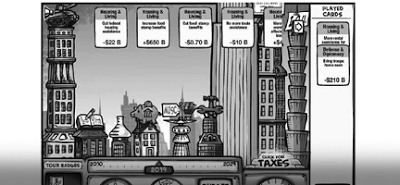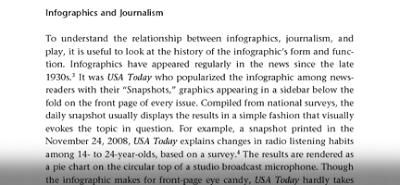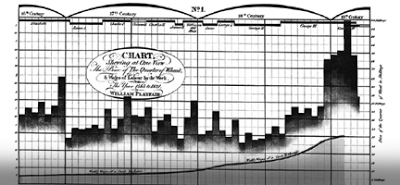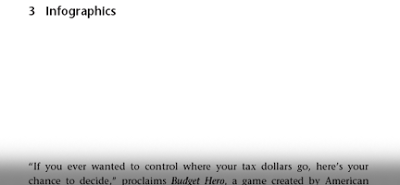Artes Visuales


 (Por Bender Baruch) A fines de septiembre, te presentamos este controvertido libro. Es que el norteamericano Ian Bogost (Associate Professor in the School of Literature, Communication, and Culture, en el Georgia Institute of Technology y socio fundador de Persuasive Games) se había metido de cabeza en el debate sobre el futuro incierto de los periódicos, o lo que para otros quiere decir la muerte del diario en papel.
(Por Bender Baruch) A fines de septiembre, te presentamos este controvertido libro. Es que el norteamericano Ian Bogost (Associate Professor in the School of Literature, Communication, and Culture, en el Georgia Institute of Technology y socio fundador de Persuasive Games) se había metido de cabeza en el debate sobre el futuro incierto de los periódicos, o lo que para otros quiere decir la muerte del diario en papel.
El 10/10/10 te dijimos que Visualmente fue el primer medio latino que entrevistó en exclusiva a Ian Bogost. Todo sobre “Newsgames: Journalism at Play”, publicado por el poderoso MIT (Massachusetts Institute of Technology), y sobre el futuro de los periódicos, la infografía, la creatividad y las facultades de periodismo, a continuación, en este especial con Lo Mejor del 2010.
1. What do you think the contact points between the infographics and games?
Digital infographics and games have a number of things in common. As layers of user input are added to the digital infographic, it starts to develop "game-like" qualities. These qualities can encourage users to manipulate data toward a goal of their choosing, to explore multitudes of outcomes via trial-and-error, to reason about the logic that produced the information in the first place, and simply to manipulate its possible configurations. An example from the United States: election results are posted on a map color-coded by which political party won that state. A person using this map might wonder how many of the states their presidential candidate would need to win if they want to win the whole election. They try clicking on different combinations of states to see all the possible configurations that would lead to their candidate winning or losing. Infographics built on a lot of data encourage users to find their own insights into the information‚ realizing new surprising facts.

(Imágenes exclusivas del libro)
2. Why do you think traditional journalists do not understand the need to change the way we tell stories and make them more creative?
Journalism is a difficult profession. It's really composed of two parts: journalists and news organizations. Journalists tell stories, conduct interviews, do research, uncover hidden truths, address injustices, highlight triumphs and look after the best interests of their citizenry. News organizations, on the other hand, find distribution methods, pay salaries, acquire advertisers, and look after the best interests of their business. Journalists are people, news organizations are companies. It's not that journalists aren't willing to try new things, it's that the news industry is reluctant to take chances, especially in times of economic hardship. Many smaller (particularly local) news agencies in the United States have had to shut down; it's hard to maintain their existing business, much less try new things. Some journalists will forever want to uphold the traditions of the printed newspaper or the investigative reporter, but so long as whatever is new isn't a gimmick, there will always be journalists who want to be on the cutting edge. Overall, institutional politics, inertia, and an inability to see new opportunities and how to exploit them, these are the factors to blame.
3. We always say that the more interactive in a newspaper on paper is a infographics. Do you think?
Edward Tufte, a statistician and infographics pioneer, has said that infographics are "instruments for reasoning about quantitative information." The infographic is a powerful tool: it makes sense of data and presents it in a legible way. Unfortunately, the infographic has often devolved into nothing but a bar graph dressed up with silly illustrations which are little more than eye-candy. But good infographics still provoke readers to think about the data being presented. Digital infographics, which add layers of interaction to the traditional method of presenting data, can be even more powerful. Not only do they reveal information, but the good ones allow readers to ask questions of that data by playing with the numbers, variables, and processes.

4. Why do you think that online news sites is repeated as a form of storytelling in the newspaper on paper?
The written news story made an easy transition to the Internet, especially in the early days when text and images were much easier to put online than video. News websites could take what was going to be printed in their newspaper and post it online‚ killing tow birds with one stone. As many companies shift their priorities to the web, they're starting to get better at taking advantage of what the Internet can offer: multimedia, linking between pages and supplementary information, user feedback, immediacy, and accessibility. But computers are more than just distribution tools for text and images—they can also run software, and that's an opportunity journalists are not taking advantage of.
5. What place do you deserve the fun in the development of infographics?
While there is nothing inherently wrong with creating entertaining graphics, the final product should never sacrifice clarity and accuracy for entertainment. Infographics‚ both print and digital‚ can be fun because they make light of information in surprising ways. They can be dressed up with illustrations or aesthetic sensibilities that make the graphic appealing to readers who might otherwise not click the link on a website, glance over it in a newspaper, or stare blankly at the television screen.
6. In Chapter 6, you talk about how Newsgames could help the formation of a journalist. How could this educational process in a professional who believes that the truth of his account information has nothing to do with a game?
Videogames cannot determine any sort of truth that is not programmed into them. If a game is about a journalist conducting interviews with the citizens in a town, the validity of anything told to the player by other characters can only be determined by what somebody programmed in ahead of time. For this reason, it's no surprise that journalists may distrust the way videogames portrays the role of truth. One game that teaches the experience of being a journalist is Global Conflicts: Palestine. In this game there is no right or wrong answer. Instead, the player is judged on how appropriate their record of information is for the political affiliation of the newspaper they selected to write for at the beginning of the game. It teaches the process of research and transparency in creating a story rather than judging what is true.

7. We believe that the crisis in newspapers has generated two migrations: the first html operators to replace the role of journalists, because they were cheaper. The second was the role of journalists out of work that became bloggers. This made the old vices of journalism begin to notice on the web. Do you think?
Journalism is not just a profession, it is a practice. An amateur can report on a factual event with the same demeanor as a professional without being a journalist. Being a journalist isn't about standing in front of a camera city hall wearing a nice suit. Nor is it about having a permanent position at a newspaper. Journalists seeks truth and verification, look after the citizenry, strive to support public discourse, and treat their subjects with equal respect and attention. In an era when anybody can publish online, it becomes even more important for professional journalists to uphold these tenets and for aspiring journalists to understand them. The reporter of the future may have to learn how to write HTML code, create animations in Flash, put together videogames, and navigated social networks, but their first obligation will be to journalism as a practice.

8. You argue in the conclusions, this book should be a wake-up call for journalists and news organizations. What should I change now, on an urgent basis?
Our argument is that journalists and news organizations should be open to changes. Newsgames are full of journalistic potential because they create systems that represent how the world operates and ask the players to understand and experience that logic. Just because the state of news reporting is changing does not mean that journalism is going away. News organization need only to look around them to realize that they already have the resources and information needed to create the next big thing. They have the people, data, research, and technology. All they lack is the willingness to take risks. The news organizations that gamble on alternative ways of pursuing the news will be the ones best prepared for rapid changes in technology and media.

9. You say, after citing Tufte, the infographics transforms raw data into visual effects, while these data sets become mechanics. You can expand a little more this concept?
A traditional bar graph or chart infographic takes a set of data and makes sense of it for the reader. This is no small feat and plays a vital role in the communication of information. But these graphics don't always say where the numbers came from, how they were manipulated, and what it would mean for them to be varied. Digital infographics can allow the reader to play so they can better understand how the conclusions in the graphic were determined. There are other kinds of infographics, like process diagrams, that explain the steps of how something came to be. Take a hurricane, for example. It is a storm created when certain atmospheric conditions are met. A newspaper in Florida realized that the best way to explain a hurricane was to let readers of its website participate in a step-by-step process to try to adjust location and temperature and wind to set a hurricane in motion. Like a videogame, it had a goal (make a hurricane) that was reached by interacting with the logic of the system (moving sliders to change variables).
10. When journalism is going to understand that games can become used to provide information?
The best way to illustrate the potential of a new technology or idea is to look at examples. In our book we examin seven categories of games that related to the news. There are current event games that bring to light the issues of today and documentary games that explore the topics of our past. There are games already in the newspaper, like the crossword puzzle. And there are already newspapers in our videogame consoles, like the Wii News Channel. Reporters, editors, and CEOs who read our book will get a taste of the variety of newsgames and the many potentials therein. There will, of course, always be bad examples of games that were created to grab headlines and make a quick buck, but the best examples stand out as a sign of things to come.
- Exclusivo: "turks Dress In Dark Colors But Have Colorful Newspapers"
El columnista de Visualmente, el peruano Elio Leturia, es entrevistado por Baris Balci para el diario turco Sabah. Allì habla sobre la situación de los medios de comunicación de la región. Will the tablet kill the newspaper? That is the question...
- Walking The Talk
(Por Elio Leturia) TWELVE JOURNALISM PROFESSORS were welcomed in early June in El Paso where the temperature hit 110 degrees. “Summer started earlier for me,” I thought. We all had been selected to participate in a multimedia training geared to...
- Working With Multimedia
(Por Elio Leturia) NOWADAYS, IN THE JOURNALISM world, multimedia is the word. People talk about audio, video, interactivity, motion graphics, slide shows. It seems that everybody has a blog and is immersed in social media. But how many people really...
- Las Infografías De Crítica En Ee.uu.
En momentos difíciles, el reconocimiento es bueno. Después del fuerte ataque de ciertos sectores de la prensa autóctona que padecimos los trabajadores del diario Crítica de la Argentina (a raíz de la renuncia del director), otros sitios extranjeros,...
- Jacob Benison In English
Nos han pedido la versión original del reportaje al artista editorial Jacob Benison. Como no es de conceder muchas entrevistas, sus colegas norteamericanos quieren aprovechar ésta para conocerlo un poco más. Además de la versión en inglés, hemos...
Artes Visuales
Lo Mejor del 2010: Viva las infografías jugables, por Ian Bogost


 (Por Bender Baruch) A fines de septiembre, te presentamos este controvertido libro. Es que el norteamericano Ian Bogost (Associate Professor in the School of Literature, Communication, and Culture, en el Georgia Institute of Technology y socio fundador de Persuasive Games) se había metido de cabeza en el debate sobre el futuro incierto de los periódicos, o lo que para otros quiere decir la muerte del diario en papel.
(Por Bender Baruch) A fines de septiembre, te presentamos este controvertido libro. Es que el norteamericano Ian Bogost (Associate Professor in the School of Literature, Communication, and Culture, en el Georgia Institute of Technology y socio fundador de Persuasive Games) se había metido de cabeza en el debate sobre el futuro incierto de los periódicos, o lo que para otros quiere decir la muerte del diario en papel. El 10/10/10 te dijimos que Visualmente fue el primer medio latino que entrevistó en exclusiva a Ian Bogost. Todo sobre “Newsgames: Journalism at Play”, publicado por el poderoso MIT (Massachusetts Institute of Technology), y sobre el futuro de los periódicos, la infografía, la creatividad y las facultades de periodismo, a continuación, en este especial con Lo Mejor del 2010.
1. What do you think the contact points between the infographics and games?
Digital infographics and games have a number of things in common. As layers of user input are added to the digital infographic, it starts to develop "game-like" qualities. These qualities can encourage users to manipulate data toward a goal of their choosing, to explore multitudes of outcomes via trial-and-error, to reason about the logic that produced the information in the first place, and simply to manipulate its possible configurations. An example from the United States: election results are posted on a map color-coded by which political party won that state. A person using this map might wonder how many of the states their presidential candidate would need to win if they want to win the whole election. They try clicking on different combinations of states to see all the possible configurations that would lead to their candidate winning or losing. Infographics built on a lot of data encourage users to find their own insights into the information‚ realizing new surprising facts.

(Imágenes exclusivas del libro)
2. Why do you think traditional journalists do not understand the need to change the way we tell stories and make them more creative?
Journalism is a difficult profession. It's really composed of two parts: journalists and news organizations. Journalists tell stories, conduct interviews, do research, uncover hidden truths, address injustices, highlight triumphs and look after the best interests of their citizenry. News organizations, on the other hand, find distribution methods, pay salaries, acquire advertisers, and look after the best interests of their business. Journalists are people, news organizations are companies. It's not that journalists aren't willing to try new things, it's that the news industry is reluctant to take chances, especially in times of economic hardship. Many smaller (particularly local) news agencies in the United States have had to shut down; it's hard to maintain their existing business, much less try new things. Some journalists will forever want to uphold the traditions of the printed newspaper or the investigative reporter, but so long as whatever is new isn't a gimmick, there will always be journalists who want to be on the cutting edge. Overall, institutional politics, inertia, and an inability to see new opportunities and how to exploit them, these are the factors to blame.
3. We always say that the more interactive in a newspaper on paper is a infographics. Do you think?
Edward Tufte, a statistician and infographics pioneer, has said that infographics are "instruments for reasoning about quantitative information." The infographic is a powerful tool: it makes sense of data and presents it in a legible way. Unfortunately, the infographic has often devolved into nothing but a bar graph dressed up with silly illustrations which are little more than eye-candy. But good infographics still provoke readers to think about the data being presented. Digital infographics, which add layers of interaction to the traditional method of presenting data, can be even more powerful. Not only do they reveal information, but the good ones allow readers to ask questions of that data by playing with the numbers, variables, and processes.

4. Why do you think that online news sites is repeated as a form of storytelling in the newspaper on paper?
The written news story made an easy transition to the Internet, especially in the early days when text and images were much easier to put online than video. News websites could take what was going to be printed in their newspaper and post it online‚ killing tow birds with one stone. As many companies shift their priorities to the web, they're starting to get better at taking advantage of what the Internet can offer: multimedia, linking between pages and supplementary information, user feedback, immediacy, and accessibility. But computers are more than just distribution tools for text and images—they can also run software, and that's an opportunity journalists are not taking advantage of.
5. What place do you deserve the fun in the development of infographics?
While there is nothing inherently wrong with creating entertaining graphics, the final product should never sacrifice clarity and accuracy for entertainment. Infographics‚ both print and digital‚ can be fun because they make light of information in surprising ways. They can be dressed up with illustrations or aesthetic sensibilities that make the graphic appealing to readers who might otherwise not click the link on a website, glance over it in a newspaper, or stare blankly at the television screen.
6. In Chapter 6, you talk about how Newsgames could help the formation of a journalist. How could this educational process in a professional who believes that the truth of his account information has nothing to do with a game?
Videogames cannot determine any sort of truth that is not programmed into them. If a game is about a journalist conducting interviews with the citizens in a town, the validity of anything told to the player by other characters can only be determined by what somebody programmed in ahead of time. For this reason, it's no surprise that journalists may distrust the way videogames portrays the role of truth. One game that teaches the experience of being a journalist is Global Conflicts: Palestine. In this game there is no right or wrong answer. Instead, the player is judged on how appropriate their record of information is for the political affiliation of the newspaper they selected to write for at the beginning of the game. It teaches the process of research and transparency in creating a story rather than judging what is true.

7. We believe that the crisis in newspapers has generated two migrations: the first html operators to replace the role of journalists, because they were cheaper. The second was the role of journalists out of work that became bloggers. This made the old vices of journalism begin to notice on the web. Do you think?
Journalism is not just a profession, it is a practice. An amateur can report on a factual event with the same demeanor as a professional without being a journalist. Being a journalist isn't about standing in front of a camera city hall wearing a nice suit. Nor is it about having a permanent position at a newspaper. Journalists seeks truth and verification, look after the citizenry, strive to support public discourse, and treat their subjects with equal respect and attention. In an era when anybody can publish online, it becomes even more important for professional journalists to uphold these tenets and for aspiring journalists to understand them. The reporter of the future may have to learn how to write HTML code, create animations in Flash, put together videogames, and navigated social networks, but their first obligation will be to journalism as a practice.

8. You argue in the conclusions, this book should be a wake-up call for journalists and news organizations. What should I change now, on an urgent basis?
Our argument is that journalists and news organizations should be open to changes. Newsgames are full of journalistic potential because they create systems that represent how the world operates and ask the players to understand and experience that logic. Just because the state of news reporting is changing does not mean that journalism is going away. News organization need only to look around them to realize that they already have the resources and information needed to create the next big thing. They have the people, data, research, and technology. All they lack is the willingness to take risks. The news organizations that gamble on alternative ways of pursuing the news will be the ones best prepared for rapid changes in technology and media.

9. You say, after citing Tufte, the infographics transforms raw data into visual effects, while these data sets become mechanics. You can expand a little more this concept?
A traditional bar graph or chart infographic takes a set of data and makes sense of it for the reader. This is no small feat and plays a vital role in the communication of information. But these graphics don't always say where the numbers came from, how they were manipulated, and what it would mean for them to be varied. Digital infographics can allow the reader to play so they can better understand how the conclusions in the graphic were determined. There are other kinds of infographics, like process diagrams, that explain the steps of how something came to be. Take a hurricane, for example. It is a storm created when certain atmospheric conditions are met. A newspaper in Florida realized that the best way to explain a hurricane was to let readers of its website participate in a step-by-step process to try to adjust location and temperature and wind to set a hurricane in motion. Like a videogame, it had a goal (make a hurricane) that was reached by interacting with the logic of the system (moving sliders to change variables).
10. When journalism is going to understand that games can become used to provide information?
The best way to illustrate the potential of a new technology or idea is to look at examples. In our book we examin seven categories of games that related to the news. There are current event games that bring to light the issues of today and documentary games that explore the topics of our past. There are games already in the newspaper, like the crossword puzzle. And there are already newspapers in our videogame consoles, like the Wii News Channel. Reporters, editors, and CEOs who read our book will get a taste of the variety of newsgames and the many potentials therein. There will, of course, always be bad examples of games that were created to grab headlines and make a quick buck, but the best examples stand out as a sign of things to come.
- Exclusivo: "turks Dress In Dark Colors But Have Colorful Newspapers"
El columnista de Visualmente, el peruano Elio Leturia, es entrevistado por Baris Balci para el diario turco Sabah. Allì habla sobre la situación de los medios de comunicación de la región. Will the tablet kill the newspaper? That is the question...
- Walking The Talk
(Por Elio Leturia) TWELVE JOURNALISM PROFESSORS were welcomed in early June in El Paso where the temperature hit 110 degrees. “Summer started earlier for me,” I thought. We all had been selected to participate in a multimedia training geared to...
- Working With Multimedia
(Por Elio Leturia) NOWADAYS, IN THE JOURNALISM world, multimedia is the word. People talk about audio, video, interactivity, motion graphics, slide shows. It seems that everybody has a blog and is immersed in social media. But how many people really...
- Las Infografías De Crítica En Ee.uu.
En momentos difíciles, el reconocimiento es bueno. Después del fuerte ataque de ciertos sectores de la prensa autóctona que padecimos los trabajadores del diario Crítica de la Argentina (a raíz de la renuncia del director), otros sitios extranjeros,...
- Jacob Benison In English
Nos han pedido la versión original del reportaje al artista editorial Jacob Benison. Como no es de conceder muchas entrevistas, sus colegas norteamericanos quieren aprovechar ésta para conocerlo un poco más. Además de la versión en inglés, hemos...
